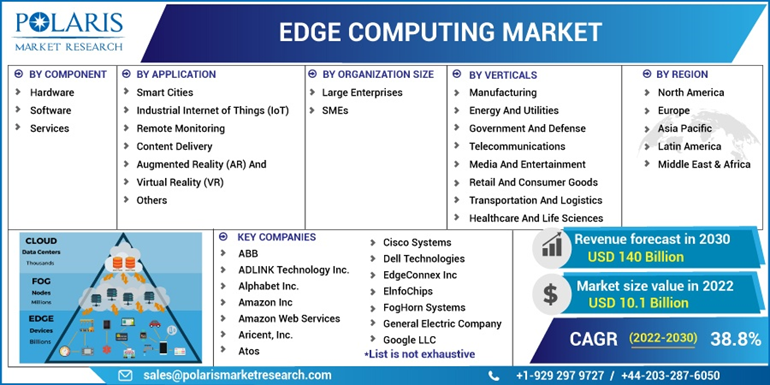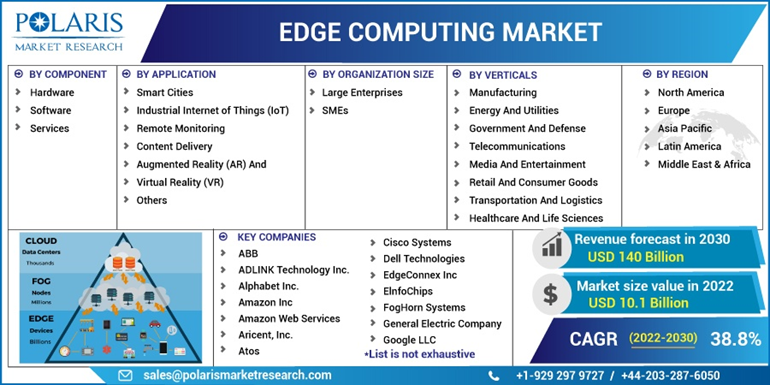Innovation in Edge Computing and Its Relationship to 5G
Edge computing is a term that refers to a diffused computing structure that creates a fusion of enterprise applications and data sources, such as local edge servers or IoT devices.

There are several advantages of this fusion, namely robust business benefits, which involve faster insights, improved feedback time, and superior bandwidth accessibility. The unequalled volumes of data produced in recent years will keep multiplying as the 5G network escalates the number of associated mobile devices. Moving device-generated data to a consolidated data center or to the cloud creates bandwidth or dormancy issues. Here, edge computing plays a valuable role in that data is processed and analyzed in proximity to where it originates. As the information does not pass over a network to a cloud or data center to be fabricated, dormancy, to a great extent, is reduced. According to the Polaris Market Research, the global edge computing market size is expected to grow at a compound annual growth rate (CAGR) of 38.8% between 2022 and 2030. The market revenue of $7.43 billion in 2021 is expected to grow up to $140 billion by 2030. Edge computing, along with 5G, are both ready to enhance application performance and push the processing of massive amounts of data in real-time. 5G is 10 times faster than 4G, and mobile edge computing can also reduce dormancy by bringing computing capacities into the network closer to the end user. Futuristically, there has to be a combination of both technologies, namely 5G or edge computing, to deliver key use cases. The primary reason is: To obtain the extraordinarily low latency required to advance use cases such as autonomous drones or remote telesurgery, the amalgamation of 5G and edge computing will be imperative. This signifies a much larger, faster pipe in co-occurrence with a brief distance for data to travel. Edge computing can be pivotal in enabling operators to transform their connecting business models. Edge computing is being utilized far and wide for several applications. Key trends include the following: For more detailed insights into this fast-growing market, read the comprehensive 118-page report by Polaris Market Research Edge Computing Market Share, Size, Trends, Industry Analysis, Segment Forecast, 2022-2030. Polaris Market Research is a market research and consulting organization providing deep-dive market insight to customers around the globe and across industry verticals. Hundreds of reports by this firm are available for purchase on MarketResearch.com. Edge computing is a term that refers to a diffused computing structure that creates a fusion of enterprise applications and data sources, such as local edge servers or IoT devices.
Edge computing is a term that refers to a diffused computing structure that creates a fusion of enterprise applications and data sources, such as local edge servers or IoT devices. 
Edge Computing and 5G: An Inextricably Linked Technology
Recent Developments in Edge Computing
In July 2022, SixSq took part in the 5G-EMERGE project to advance results that use 5G technology and satellite broadcasting and allow the distribution of high-quality content services spanning Europe.
In November 2021, Litmus acquired Kickdynamic to augment its portfolio with content automation and AI-guided product. With Kickdynamic, Litmus can build, test, and collaborate on extensive volumes of emails and offer customized email customer experience.
In April 2022, Dell Technologies augmented its edge solutions to assist retailers in speedily creating more value and improving customer experiences with data generated in retail locations. From grocery publicizing and curbside collection to smooth checkout and loss prevention, retailers have welcomed edge technologies to be at par with industry demands and generate unparalleled customer experiences.
Edge Computing Trends
Where to Learn More
About Polaris Market Research

 Fransebas
Fransebas 











![Which Instagram Story Formats Really Engage Viewers [New Research]](https://blog.hubspot.com/hubfs/marketer-creates-instagram-story-content%20%281%29.jpg#keepProtocol)




















